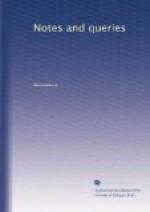* * * * *
REPLIES.
LUTHER’S TRANSLATION OF THE NEW TESTAMENT.
Luther’s solemn request that his translation should on no account be altered, accompanies most of the earlier editions of the N.T. I find it on the reverse of the title-page of the edition in 8vo. printed at Wittemberg by Hans Lufft in 1537, thus:—
“I request all my friends and enemies, my master printer, and reader, will let this New Testament be mine; and, if they have fault to find with it, that they make one of their own. I know well what I do, and see well what others do; but this Testament shall be Luther’s German Testament; for carping and cavilling is now without measure or end. And be every one cautioned against other copies, for I have already experienced how negligently and falsely others reprint us."[1]
The disputed verse (1 John, v. 7.) is omitted in all the editions printed under Luther’s eye or sanction in his lifetime; but it has not, I think, been remarked that in verse 8. the words auf erde, found in later editions, are wanting. The passage stands:—
“Denn drey sind die
da zeugen, der Geist, und das Wasser, und
das Blut, und die drey sind
beysamen.”
In the first edition of the Saxon (Duedesche version of Luther’s Bible, by Jo. Heddersen, printed in a magnificent volume at Lubeck, by Lo. Dietz, in 1533-4), the verse stands thus:—
“Wente dre synt dede
tuechinisse geven, de Geist unde dat Water,
unde dat Bloth, unde de dre
synt by emander.”
A MS. note of a former possessor remarks:—
“The 7th verse is not
found here, nor is it in the Bibles of
Magdeburg, 1544, of Wittemberg,
1541, ditto 1584, Frankfort,
1560 and 1580.”
In the edition of this same version, printed by Hans Lufft, Wittemberg, 1541, the passage is exactly similar; but in one printed by Hans Walther, Magdeburg, 1545, the words up erdeu are inserted.
These Saxon versions are interesting from the very great similarity that idiom has to our early language; and they, doubtless, influenced much our own early versions.
In a translation of the N.T. from the Latin of Erasmus (the first printed in Latin with a translation on the same page, and which is very similar in appearance to Udal’s), printed at Zurich in 1535, 4to., with a Preface by Johansen Zwikk of Constance, the 7th verse is given (as it was in the Latin); but is distinguished by being printed in brackets, and in both verses we have—
“Unnd die drey dienend in eins.”
Erasmus having admitted the verse into his third edition, gave occasion perhaps to the liberty which has been taken in later times to print both verses, with this distinction, in editions of the Lutheran version. The earliest edition, I believe, in which it thus appears, is one at Wittemberg in 1596, which was repeated in 1597, 1604, 1605[2], and 1625. It also appears, but printed in smaller type, in the Hamburgh Bible by Wolder in 1597, in that of Jena 1598, and in Hutter’s Nuremburg, 1599.




